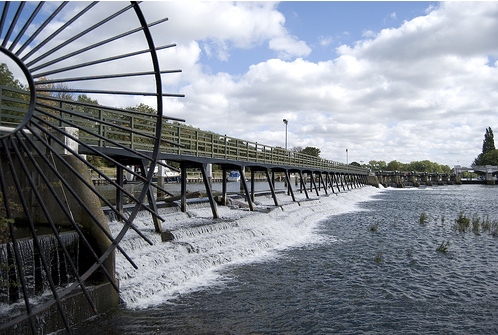Teddington Weir to provide renewable energy
 The Government Environment Agency has announced plans to develop Teddington weir in order produce ‘green power’.
The Government Environment Agency has announced plans to develop Teddington weir in order produce ‘green power’.
Weirs are created to manage water levels and reduce flood risk but environmental activists say can also be used to generate energy and help tackle climate change and help reduce the impact of energy crises.
Teddington has one of three weirs (out of a total of 44) on the Thames that is being considering by the Environment Agency to harness the power of the river using the renewable energy source of hydropower wherever it is feasible.
Although only generating power on a small-scale, these pilot schemes will provide good case studies for larger scale future developments. Another scheme at Romney Weir at Windsor is planned to be operational by the end of this year.
The EA won’t develop these sites itself but instead offer the work out to tender for developers to submit plans.

Photo: Jacques De Molay








Hi there,
I am one of the lock staff at Teddington and feel that i should point out that the weir is not in need of an ‘overhaul’ having been rebuilt completely about 20 years ago , it still has many years of life left in it . You are correct however in that the EA has invited companies to tender for installing a hydroelectric scheme. All the lock staff are excited about the prospect of the weir being used to provide renewable energy.
Best wishes
Hi Howard, apologies but I miss-understood the text from the Chronicle article – now amended!
I think this is great. The EA should invite local people to invest in it – as a community investment company. This has been done elsewhere and is an excellent way to get people directly involved:
http://www.guardian.co.uk/money/2010/may/29/ethical-investments-communities-environment
After years of surveying the feasibility of Hydro for the Thames (and lots of other rivers) we are pleased to be associated with providing detailed technical and other best practice information for the agenda.
We have initiated and closely assisted the formation of the community project at Teddington and will continue to press for the very best practice at this site for ALL the stakeholders.
Best Regards
There used to be 600 hydro projects on the Thames and now there is the opportunity to reinstate some of them.
Hydropower at Teddington
A response from the Thames Anglers’ Conservancy
As we rightly advance our collective responsibilities to generate cleaner energies, locally and nationally, it appears that a myth has been born concerning hydropower and its efficacy in producing ‘green’ energy on a local level.
At the Thames Anglers’ Conservancy’s request we were recently invited to respond to an initial project brief from Ham Hydro regarding their proposals for Teddington Weir, that being the installation of four Archimedes screws which could possibly generate 1,863,113 kWhs of electricity per annum for the ‘local’ economy. This equates to approximately enough electricity to supply 100 homes, it is said, and would reduce carbon emissions to the tune of 1013 tonnes, costing approximately £2.5mn, which all sounds great, so what’s the problem?
Used within the project brief as examples of the energy yield are the award winning Torrs and Settle hydro schemes and neither project has come anywhere near fulfilling the promises made in that regard. Torrs has only produced 52% of its projected energy yield in the first 26 months of its operation, and Settle had produced only 44% in the first 32 weeks (albeit with the rainier seasons to come). All percentages were extrapolated from their own figures taken at the end of November 2010.
So what does that mean? It means that those that are investing in such schemes will have to potentially wait twice as long for their investment to produce a ‘profit’ to promote further local carbon initiatives in the future, if ever? It also suggests that the projected yield may be considerably less than proposed and subsequently the carbon savings will also be proportionally lowered to the same degree?
Incidentally, the figure of the ‘number of homes’ that hydropower facilitates in project briefers and the like, generally does not include any energy used for heating, which is widely accepted as being an average of 89% of total energy use within the average household?
Concerning carbon savings in the local area there have been several concerns raised by the Thames Anglers’ Conservancy (TAC). Richmond upon Thames produces 681,000 tonnes of Household & Vehicle Co2 emissions per annum (Energy Saving Trust Green Fleet Review – 2007), and that the nearby Heathrow airport produces around 31mn tonnes pa. The potential saving of 1013 tonnes of carbon emissions, weighed up against the risk of permanently damaging the aquatic environment of the River Thames, seem to be bordering on total insanity!
Would it not be best to propose carbon savings locally through proven methods of carbon reduction, £2.5mn pounds could go a long way in raising awareness to ensure local people understand how best to use energy within their own homes, and subsequently save them money, as well as ensuring that tens of thousands of tonnes of carbon are never produced in the first place! As usual it appears we are careering head first into making superficial gestures with a nod towards a ‘greener’ way of living through promoting the wide scale use of hydropower, while we continue to avoid the basic principles of developing a sustainable relationship with our environment.
For the TAC the irreversible risk that hydropower brings to our riverine ecologies is one that defies sound environmental and conservational logic, the cumulative promotion of such projects will irrevocably damage the river’s ecology, “water is a renewable source but a healthy river is not”.
Do a little research yourself and I’m sure it won’t be too long before you begin to raise similar concerns yourself, the Thames Anglers’ Conservancy and many other environmental groups certainly are, and it may well be that small scale hydropower is little more than a pig in a poke.
Thames Anglers’ Conservancy